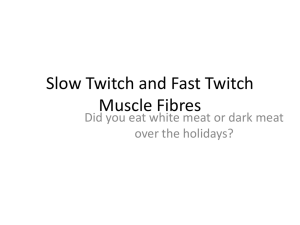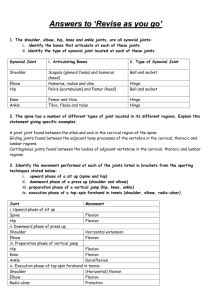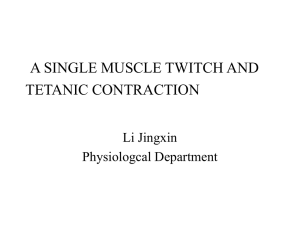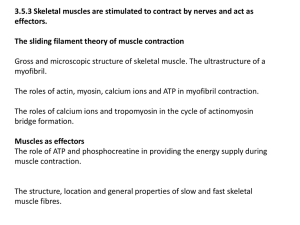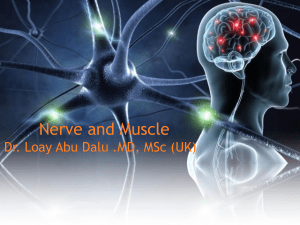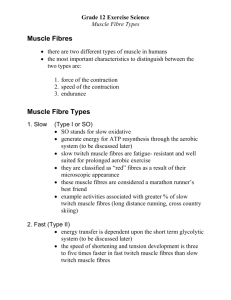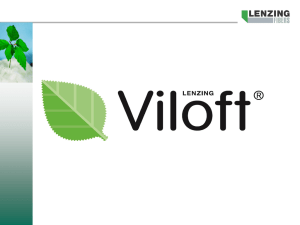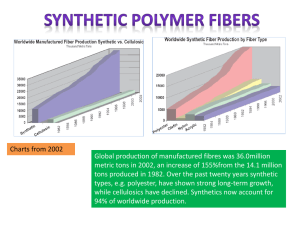Movement Terminology Live Show
advertisement
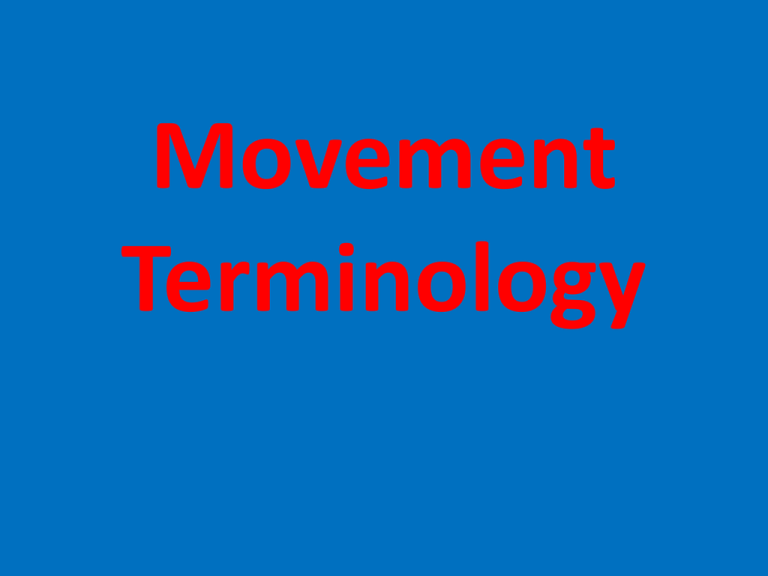
Movement Terminology On whiteboards What are movement types, what do we call the motions at joints? Activity 1 For the following joints write down the movement that can happen at that joint • • • • • • • • Wrist Radio-Ulna Elbow Shoulder Vertebrae Hip Knee Ankle • • • • Wrist Radio-Ulna Elbow Shoulder • Vertebrae • Hip • Knee • Ankle EXTENSION,PALMAR FLEXION PRONATION & SUPINATION . FLEXION & EXTENSION. ADDUCTION, ABDUCTION, FLEXION, EXTENSION, ROTATION, CIRCUMDUCTION FLEXION,EXTENSION,LATERAL FLEXION ADDUCTION, ABDUCTION, FLEXION, EXTENSION, ROTATION. FLEXION & EXTENSION DORSI FLEXION & PLANTAR FELXION COMPLETE WS 1 Activity 2 What are the muscular contraction types? Isotonic (Concentric/Eccentric), Isometric and Isokinetic Using a Bicep curl explain the 3 main contraction types ? •During the upward phase bicep brachii contracts and shortens and flexes elbow performing concentric contraction •During downward phase bicep brachii under tension lengthens and extends elbow performing eccentric contraction •If elbow held at 90* bicep under tension but no movement therefore isometric contraction Complete WS 2/3, WS 12, WS 13 MOVEMENT ANALYSIS of a SPORTING ACTION Physical activity joint used movement pattern agonist muscle LEG ACTION IN SPRINTING ankle plantarflexion gastrocnemius, soleus knee flexion followed by extension hip flexion (KNEE LIFT) (REAR LEG DRIVE) hip extension type of muscular contraction (isotonic) eccentric, followed by concentric exercise to improve strength quadriceps group eccentric followed by concentric squats, jumping upwards onto boxes rectus abdominus, concentric pike sit-ups, V-sits concentric back hyperextension iliopsoas gluteus maximus calf raise, plyometric jumping exercises, hopping THIS SEQUENCE COVERS ONE FULL STRIDE FOR ONE LEG Module 2562 A.1.7 Skeletal Muscle • Using IS 1 highlight the key words and add to you key words glossary Muscle fibre types Can you recall the types of muscles fibres? •TYPE 1 – SLOW OXIADATIVE •TYPE IIA – FAST OXIADATIVE •TYPE IIB – FAST GLYCOLYTIC What is the factor that causes us to have a mixture of muscle fibre types? •GENETICS Muscle fibre types COMPLETE THE FOLLOWING TABLE: CHARACTERISTIC TYPE 1 Contraction speed slow Motor neurone size small Force production low Fatigability Mitochondria high Myoglobin Glycogen store low Aerobic capacity Anaerobic capacity TYPE IIA fast large lower duration lower lower medium medium TYPE IIB fast high very high low high low COMPLETE THE FOLLOWING TABLE: CHARACTERISTIC TYPE 1 Contraction speed slow Motor neurone size small Force production low Fatigability long duration Mitochondria high Myoglobin high Glycogen store low Aerobic capacity high Anaerobic capacity low TYPE IIA fast large high lower duration lower lower medium medium medium TYPE IIB fast large high very high low low high low high Effects of training on muscle fibres • You can increase the size of muscle fibres • Increase in size is ‘HYPERTROPHY’ • In Hypertrophy increased quantity and size of myofibrils per fibre STRUCTURE of a SARCOMERE • the Z lines are the ends of the sarcomere • which are attached to actin filaments which comprise the I zone of the relaxed unit • the myosin filaments lie in between actin filaments which they just overlap (relaxed) • the H zone is the space between the ends of the actin filaments CONTRACTION • during contraction the cross-bridges between the myosin and actin filaments pull them towards one another • this increases the overlap and pulls the Z lines towards one another Sliding filament theory demo http://www.youtube.com/watch?v=pWP1u7rRJS8 MOTOR NEURONE STRUCTURE CELL BODY • includes nucleus and cytoplasm • membrane is receptive to stimuli from other neurones DENDRITES • highly branched processes which extend out from the cell body • specialised to receive stimuli from sensory organs or from other neurones AXON • conducts nerve impulses to other cells (nerve, muscle, gland cells) • special structures include : – myelin sheath insulates nerve – nodes of Ranvier are gaps in myelin sheath where action potential jumps from node to node – axon terminal ends with synaptic end bulbs containing neurotransmitter substances – enabling action potential to be applied to adjacent cells Module 2562 A.1.15 Motor Unit demo http://www.youtube.com/watch?v=XKb20ri05pQ http://www.youtube.com/watch?v=oKr04bsVF3M&feature=related FIBRE TYPE and EXERCISE RECRUITMENT • based on intensity of exercise • at low intensity ST motor units recruited first • at higher intensity FO FT IIa motor units recruited • at greatest intensity FG FT IIb motor units recruited to produce powerful fast muscle contractions all available fibres are recruited for all power activities • RESPONSES TO TRAINING • endurance training results in type IIb being converted to type IIa • endurance training increases the aerobic capacity of ST fibres • explains why long steady training results in loss of speed • high intensity anaerobic training causes increase in size of FT fibres (hypertrophy), and number of FT fibres (hyperplasia) • lack of training causes atrophy FIBRE TYPE RANGE IN SPORTS PERFORMERS activity average % ST MALES marathon 81 cross country skiers 64 cyclists 59 800m runners 52 untrained 47 shot putters 39 sprinters 40 FEMALES cross country skiers cyclists 800m runners untrained shot putters sprinters 59 54 62 53 53 32 range of % ST 50 - 98 52 - 75 52 - 72 40 - 62 42 - 76 19 - 57 20 - 53 47 - 74 37 - 66 44 - 73 30 - 72 50 - 55 28 - 32 – proportions of fibre types are genetically determined – this could account for specialisms of individuals 1.Which fibre type? • Marathon • Distance swimmer • Basketball • Endurance cyclist • Long jump • Sprinter 2.What difference is there between male and female performers in these sports in terms of fibre types? 3.Will a 40 year old runner have different fibre types from when they were 20 4.Why is a warm up important regards to fibre types? 5.How can you adapt training sessions so that you just overload either slow or fast firbers? 6.What is the sliding filament theory?
